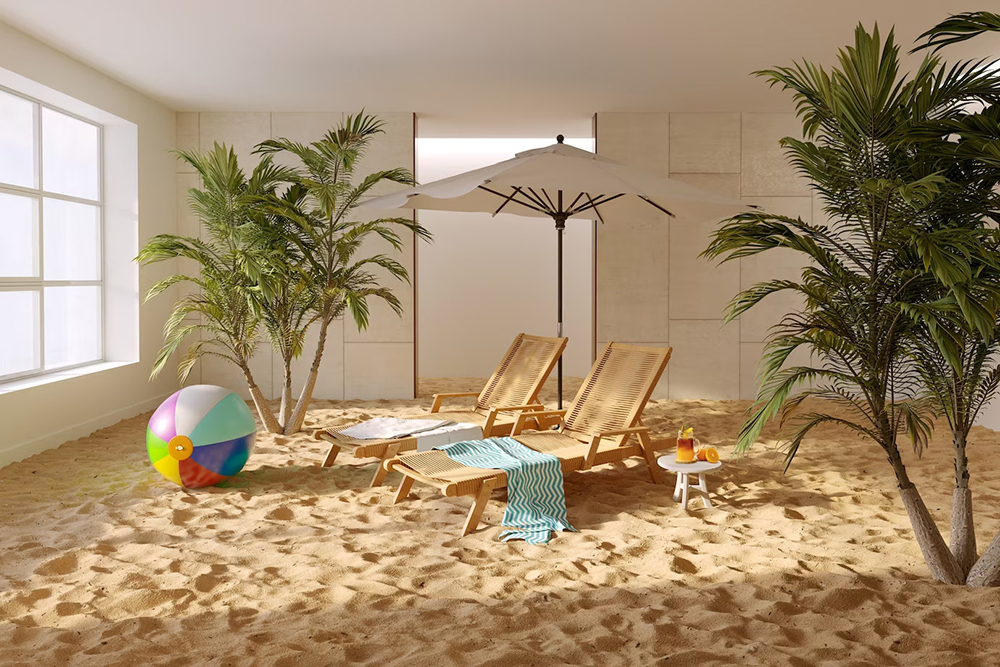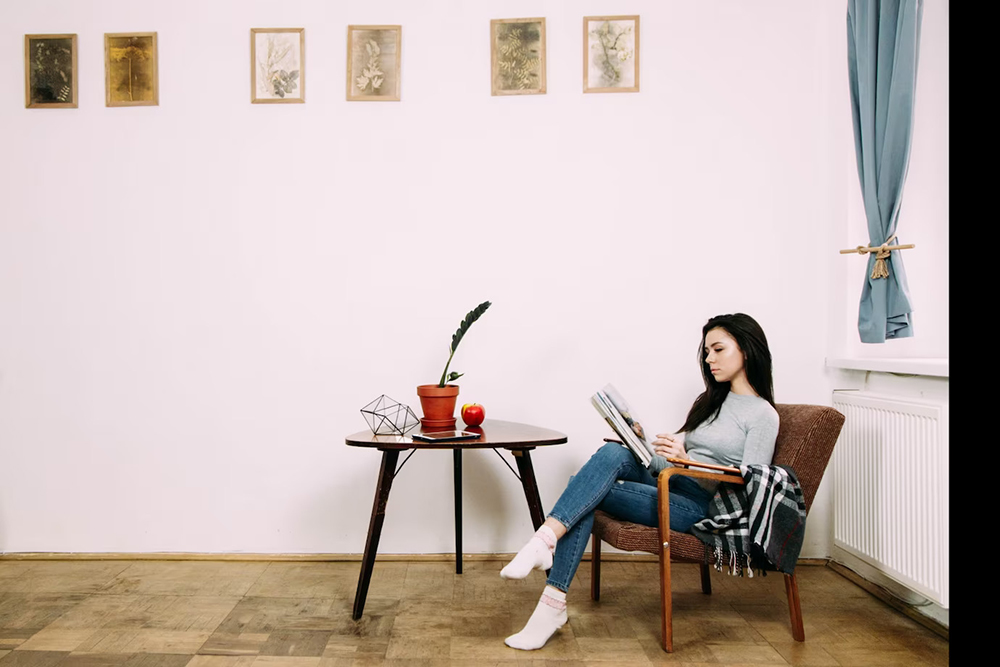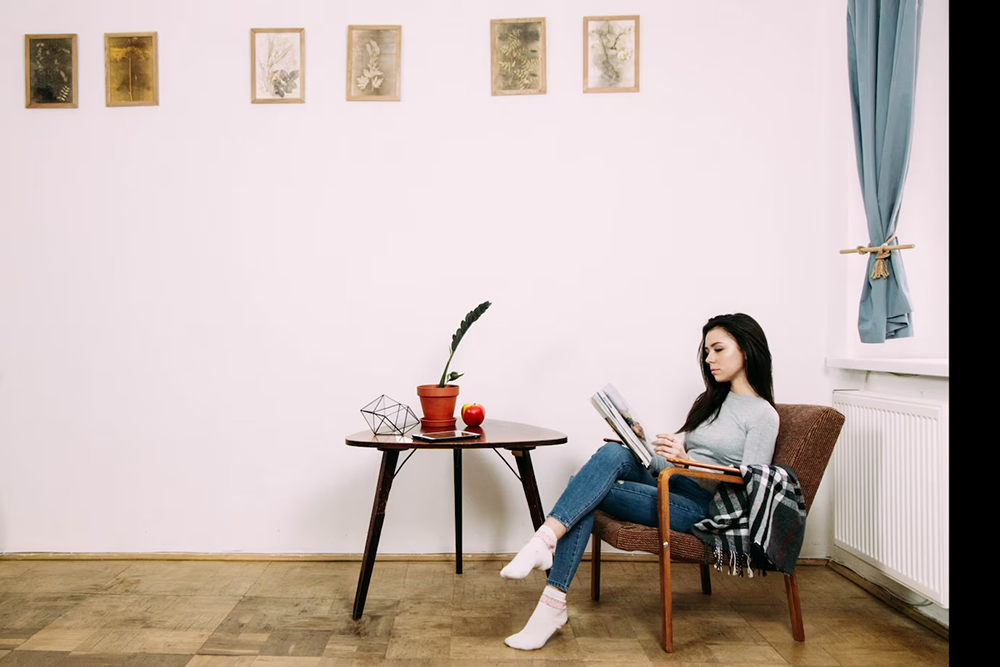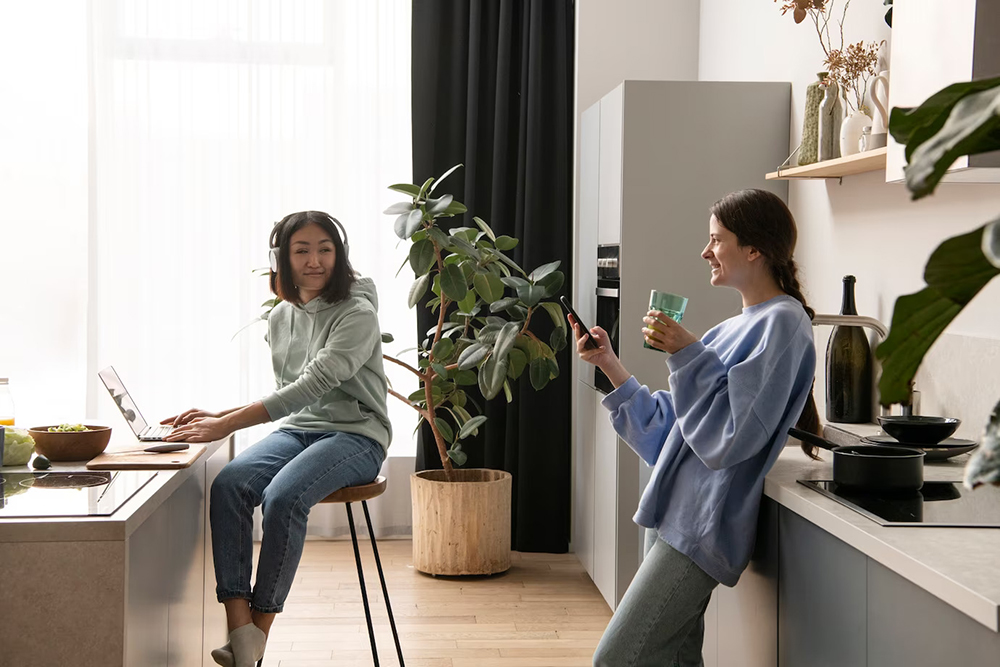
by Admin | Jul 31, 2023 | Decor
Coastal-inspired decor, also known as beachy or nautical decor, brings the relaxed and breezy vibes of the seaside into your home. It is a style that captures the essence of coastal living, evoking a sense of tranquility, freshness, and connection with nature. Whether you live near the beach or not, coastal-inspired decor allows you to create a serene and inviting living space that reminds you of soothing ocean waves and sandy shores. Here’s a detailed look at the coastal-inspired decor and how you can infuse beachy vibes into your home:
A Calming Color Palette:
The foundation of coastal-inspired decor lies in a calming color palette. Think of soft and cool tones reminiscent of the ocean, such as light blues, seafoam greens, sandy beige, and white. These colors create a sense of openness and serenity, making your living space feel fresh and inviting.
Nautical Elements and Motifs:
Incorporate nautical elements and motifs into your decor to evoke a seaside atmosphere. Look for accessories like anchors, ship wheels, ropes, and seashells to add a touch of maritime charm to your space. These decorative elements can be used as wall art, on throw pillows, or as decorative pieces on shelves.
Natural Materials:
Coastal-inspired decor embraces natural materials that mimic the elements found at the beach. Incorporate textures like rattan, jute, wicker, and driftwood to create a coastal feel. Furniture and decor made from these materials add warmth and rustic touch to your space.
Light and Airy Fabrics:
Choose light and airy fabrics for curtains, throw pillows and upholstery. Sheer curtains allow natural light to filter through, creating a bright and airy ambiance. Opt for soft and comfortable fabrics like cotton and linen to enhance the relaxed coastal vibe.
Stripes and Patterns:
Stripes are a classic element of coastal decor. Incorporate striped patterns into your home through area rugs, throw blankets, or bedding. Striped patterns add a sense of movement and energy, mimicking the rhythm of ocean waves.
Coastal-Inspired Furniture:
Choose furniture that reflects the casual and laid-back nature of coastal living. Look for pieces with clean lines and a weathered or distressed finish. Wicker furniture and light-colored wood pieces are excellent choices for a coastal-inspired look.
Ocean-Inspired Artwork:
Incorporate ocean-inspired artwork into your decor to create a focal point in your living space. Seascapes, beach scenes, and marine life artwork are great options for bringing the beauty of the ocean indoors.
Seashells and Beachcombing Find:
Collect seashells and beachcombing finds during your beach trips and use them as decor in your home. Display them in glass jars or bowls on tables or shelves to bring a touch of the beach into your living space.
Coastal-Inspired Lighting:
Choose lighting fixtures that complement the coastal vibe. Rattan pendant lights, woven lampshades, or driftwood-inspired chandeliers add a beachy touch to your space while providing warm and cozy illumination.
Outdoor Living Space:
Extend the coastal-inspired decor to your outdoor living space. Create a beachy oasis on your patio or balcony with comfortable outdoor furniture, throw pillows in coastal colors, and potted plants that mimic the beach landscape.
Nautical Maps and Charts:
Nautical maps and charts add an authentic touch to the coastal-inspired decor. Frame vintage maps or charts of your favorite coastal areas and use them as wall art in your living space.
Ocean-Scented Candles and Diffusers:
Enhance the coastal ambiance with ocean-scented candles and diffusers. Scents like sea breeze, salt water, and coconut evoke the essence of the beach and create a soothing atmosphere.
Beachy Bathroom Decor:
Incorporate coastal elements in your bathroom decor as well. Use seashell-shaped soap dishes, coastal-themed shower curtains, and beach-inspired wall art to create a relaxing beach resort feel.
Casual and Inviting Layout:
Embrace a casual and inviting layout in your living space. Arrange furniture in a way that promotes easy conversation and relaxation, creating a welcoming environment for family and friends.
Personalize Your Coastal Decor:
Above all, personalize your coastal-inspired decor to reflect your own beachy memories and experiences. Display beach vacation photos, showcase souvenirs from your travels and add personal touches that make the space uniquely yours.
Conclusion:
The coastal-inspired decor brings the tranquility and beauty of the beach into your living space. By incorporating a calming color palette, nautical elements, and natural materials, you can create a serene and inviting ambiance that reminds you of the seaside. Embrace ocean-inspired artwork, coastal lighting, and beachcombing finds to enhance the beachy vibe. Whether you live near the coast or not, coastal-inspired decor allows you to create a relaxing and laid-back environment that celebrates the joys of coastal living and encourages a connection with nature. Embrace the beachy vibes and create a coastal retreat in your home where you can unwind and embrace the beauty of the ocean.

by Admin | Jul 31, 2023 | Decor
Bohemian chic, also known as boho-chic, is an eclectic and free-spirited style that celebrates individuality, creativity, and a laid-back lifestyle. This design trend draws inspiration from various cultures, art forms, and eras, resulting in a unique and visually captivating aesthetic. Incorporating bohemian chic into your home allows you to create a space that reflects your personality, interests, and adventurous spirit. Here’s a closer look at bohemian chic style and how you can infuse it into your home decor:
Embrace Rich and Vibrant Colors:
Bohemian chic style is characterized by its rich and vibrant color palette. Think jewel tones, earthy hues, and pops of bold colors. Incorporate these colors into your home through textiles, wall art, and accent pieces to create a vibrant and lively atmosphere.
Mix and Match Patterns:
Bohemian chic embraces an eclectic mix of patterns and prints. Combine floral, geometric, paisley, and ikat patterns to add visual interest to your space. Don’t be afraid to experiment with contrasting patterns; it’s all about creating a harmonious and bohemian vibe.
Layered Textures and Fabrics:
The texture is a crucial element in bohemian chic decor. Layer textiles like throws, pillows, and rugs in various textures such as fringe, macrame, and woven fabrics. Incorporate plush velvet or faux fur elements for added luxury and coziness.
Global and Artistic Accents:
Bohemian chic draws inspiration from different cultures, making it the perfect style to incorporate global and artistic accents. Handmade pieces, artisanal crafts, and ethnic-inspired decor items add depth and character to your space.
Statement Furniture and Vintage Finds:
Add personality to your home with statement furniture pieces and vintage finds. Look for unique pieces with intricate detailing or a distressed finish. Vintage furniture and accessories bring a sense of history and charm to your bohemian chic space.
Integrate Natural Elements:
Incorporate natural elements like plants, rattan furniture, and wooden accents to infuse a bohemian vibe. Plants not only add greenery but also contribute to a sense of well-being and a connection with nature.
Cozy Bohemian Nooks:
Create cozy nooks in your home with plush floor cushions, poufs, and floor pillows. These intimate spaces encourage relaxation and serve as inviting spots for lounging or reading.
Eclectic Wall Decor:
Bohemian chic wall decor is all about displaying an eclectic mix of artwork, tapestries, and mirrors. Create a gallery wall with a combination of framed prints, paintings, and woven wall hangings for an eye-catching display.
Lush and Romantic Lighting:
Opt for warm and soft lighting to enhance the bohemian ambiance. String lights, Moroccan lanterns, and candles create a romantic and dreamy atmosphere.
Free-Spirited Vignettes:
Create free-spirited vignettes around your home by arranging curated collections of your favorite trinkets, souvenirs, and mementos. These little displays add a personal touch and showcase your adventures and memories.
Flowing and Sheer Curtains:
Bohemian chic decor often incorporates flowing and sheer curtains that add a touch of whimsy and a soft, dreamy feel to the space. These curtains also allow natural light to filter through, creating a bright and airy atmosphere.
Vintage Rugs and Kilims:
Layer vintage rugs and kilims to add warmth and texture to your floors. These unique textiles not only add color but also serve as artful focal points in a bohemian chic space.
Create an Outdoor Oasis:
Take the bohemian chic style outdoors by creating a cozy and eclectic outdoor oasis. Use colorful textiles, string lights, and boho-inspired furniture to transform your patio or balcony into a laid-back retreat.
Embrace Imperfection:
The bohemian chic style celebrates imperfection and embraces the beauty of handmade and artisanal items. Don’t be afraid to mix and match items that may not seem traditionally cohesive – it’s all about embracing the charm of imperfection.
Personalize Your Space:
Above all, bohemian chic style is about personal expression and creating a space that truly reflects your individuality and interests. Infuse your home with items that hold sentimental value and evoke positive emotions.
Conclusion:
Bohemian chic style offers a playful and eclectic approach to home decor, celebrating individuality and creativity. With its vibrant colors, mix of patterns, and emphasis on natural elements, bohemian chic allows you to create a free-spirited and inviting space that reflects your unique personality and sense of adventure. Embrace rich colors, layer textures, and incorporate global accents to infuse a bohemian vibe into your home. Whether you’re creating cozy nooks or displaying a curated gallery wall, bohemian chic style invites you to let your imagination roam freely and create a space that brings joy, comfort, and inspiration to your daily life.

by Admin | Jul 31, 2023 | Decor
Color psychology plays a significant role in interior design, as colors have the power to evoke emotions, set the mood, and create a specific atmosphere in a living space. When used thoughtfully, colors can influence our feelings, behaviors, and overall well-being. From calming and serene to energizing and vibrant, the right color choices can transform your home into a place that resonates with your emotions and enhances your daily experiences. Here’s a closer look at color psychology in home decor and how you can use it to create the desired mood and atmosphere:
Understanding Color Psychology:
Color psychology is the study of how colors affect human behavior, emotions, and mood. Different colors evoke distinct feelings and responses, making them a powerful tool in interior design. Warm colors like red, orange, and yellow are associated with energy and excitement, while cool colors like blue, green, and purple are linked to calmness and relaxation.
Calm and Tranquility:
For spaces where you want to create a sense of calm and tranquility, consider using cool colors like soft blues, light greens, and lavender. These colors promote relaxation and a peaceful atmosphere, making them ideal for bedrooms, living rooms, and meditation spaces.
Energetic and Vibrant:
To infuse energy and vibrancy into a room, opt for warm colors like red, orange, and bright yellow. These colors can stimulate creativity and conversation, making them suitable for areas like dining rooms or spaces where you want to encourage social interaction.
Neutral and Serene:
Neutral colors like beige, cream, and gray can create a sense of serenity and balance in a room. They serve as a versatile backdrop for other colors and provide a soothing ambiance in any space.
Cozy and Warm:
To create a cozy and inviting atmosphere, use warm and earthy tones like terracotta, deep browns, and warm grays. These colors can make a room feel intimate and welcoming, making them suitable for living rooms and bedrooms.
Cheerful and Playful:
Bright and playful colors like coral, turquoise, and lime green can add a touch of cheerfulness and playfulness to a room. Consider using these colors in children’s rooms, playrooms, or areas where you want to create a lighthearted atmosphere.
Balance and Harmony:
Using a balanced combination of colors can create a harmonious and visually appealing space. Consider using the 60-30-10 rule, where 60% of the room is a dominant color, 30% is a secondary color, and 10% is an accent color.
Consider Cultural Associations:
It’s essential to consider cultural associations and personal preferences when choosing colors for your home. Different cultures may have varying interpretations of colors, so it’s essential to choose colors that resonate with you and your family.
Lighting and Space:
Keep in mind that lighting and the size of a room can influence how colors appear. Natural light can enhance the vibrancy of colors, while artificial lighting may create a different ambiance. In small spaces, using light and neutral colors can make the room feel more open and spacious.
Test Before Committing:
Before painting an entire room or investing in large furniture pieces, test the colors in the space. Paint small swatches on the wall or use fabric samples to see how the colors interact with the existing elements in the room.
Create Flow with Color:
In open-concept spaces, use a consistent color palette to create a sense of flow and cohesiveness throughout the area. This approach ties different areas together and makes the space feel unified.
Layering with Colors:
Don’t be afraid to layer colors on your home decor. Mix and match different hues, shades, and tints to create depth and visual interest in your space. This can be achieved through the use of throw pillows, rugs, artwork, and other accessories.
Use Colors to Highlight Features:
Colors can be used strategically to highlight architectural features or focal points in a room. For example, a bold accent color on an accent wall can draw attention to a fireplace or an interesting architectural detail.
Flexibility in Home Decor:
Remember that colors in home decor are not permanent fixtures. You can easily update the mood and atmosphere of a room by changing accessories like throw pillows, curtains, and artwork.
Personal Expression:
Ultimately, color psychology is a tool to enhance your living space and create an environment that reflects your personality and preferences. Use colors in a way that brings joy and comfort to you and your family.
Conclusion:
Color psychology in home decor is a powerful tool that allows you to shape the mood and atmosphere of your living space. From calming and serene to energetic and vibrant, the right colors can evoke specific emotions and enhance your overall well-being. When choosing colors for your home, consider the feelings and emotions you want to evoke in each space. With thoughtful color choices and a well-planned design, you can create a harmonious and inviting environment that reflects your personal style and enriches your daily experiences in your home.

by Admin | Jul 31, 2023 | Decor
Minimalist home decor is a design philosophy that embraces simplicity, functionality, and a clutter-free environment. Rooted in the belief that less is more, minimalist design focuses on essential elements, clean lines, and a calming atmosphere. This style promotes a sense of tranquility and order, making it an increasingly popular choice for homeowners seeking to create a serene and inviting living space. Here’s a closer look at minimalist home decor and how you can embrace simplicity and functionality in your own home:
Declutter and Simplify:
The first step in achieving minimalist home decor is to declutter and simplify your space. Start by removing unnecessary items and belongings that do not serve a purpose or bring you joy. Embrace the “less is more” approach, keeping only essential and meaningful items in your living space.
Clean Lines and Uncluttered Spaces:
Minimalist design is characterized by clean lines and uncluttered spaces. Avoid ornate details and excessive decorations. Instead, opt for sleek and simple furniture with streamlined silhouettes. The focus should be on creating a sense of openness and harmony within each room.
Neutral Color Palettes:
Minimalist home decor often incorporates neutral color palettes, such as whites, grays, and earthy tones. These colors create a calming and timeless backdrop, allowing other elements in the room to stand out without overwhelming the senses.
Functional Furniture:
Choose furniture that is not only aesthetically pleasing but also functional. Look for pieces with built-in storage or multi-purpose features to maximize space efficiency. Avoid bulky furniture and opt for pieces that fit the scale of your room while providing ample functionality.
Thoughtful Decorative Elements:
In minimalist home decor, decorative elements are kept to a minimum but are thoughtfully chosen. Select a few statement pieces or artwork that align with your personal style and enhance the overall aesthetic without overcrowding the space.
Quality over Quantity:
Minimalism encourages investing in high-quality items that will stand the test of time. Rather than purchasing numerous inexpensive decor pieces, focus on acquiring a few well-crafted items that bring joy and add value to your living space.
Introduce Natural Elements:
Bringing in natural elements like indoor plants, wooden accents, and stone textures can add warmth and serenity to a minimalist space. These elements create a connection with nature, promoting a sense of tranquility and well-being.
Open and Airy Layout:
A minimalist home often features an open and airy layout, allowing for a seamless flow between rooms. Eliminate unnecessary walls or dividers to create a sense of spaciousness and connectivity within your living space.
Hidden Storage Solutions:
Incorporate hidden storage solutions to keep clutter out of sight. Utilize built-in cabinets, floating shelves, and under-bed storage to maintain a clean and organized environment.
Quality Lighting:
Invest in quality lighting fixtures that provide ample illumination while complementing the overall design. Consider natural light as much as possible, and opt for light fixtures that blend seamlessly with the minimalist aesthetic.
Mindful Placement of Decor:
In minimalist home decor, the placement of decor is crucial. Avoid overcrowding shelves or tabletops and instead, space out decorative elements to create a sense of balance and visual harmony.
Tranquil Bedrooms:
In the bedroom, focus on creating a tranquil and relaxing environment. Stick to a simple color scheme and opt for a comfortable and clutter-free sleep space that promotes rest and relaxation.
Limit Technological Clutter:
While technology is essential in modern living, try to limit its visual impact. Conceal cords and wires as much as possible, and opt for sleek and minimalistic electronic devices to maintain a clean and tidy look.
Mindful Entryways:
The entryway sets the tone for your home, so keep it clutter-free and welcoming. Choose a functional shoe rack or bench for practicality and add a few key decorative elements to create a warm and inviting first impression.
Embrace Your Personal Style:
Minimalism does not mean sacrificing personal style. Embrace your unique preferences and incorporate elements that resonate with your personality and lifestyle. Minimalist home decor is about curating your space intentionally to reflect what brings you joy and a sense of peace.
Conclusion:
Minimalist home decor embraces simplicity and functionality, creating spaces that are calm, organized, and visually appealing. By decluttering, using clean lines, and choosing a neutral color palette, you can achieve a minimalist aesthetic that promotes a sense of tranquility and well-being in your living space. Embrace quality over quantity, invest in functional furniture, and incorporate natural elements to create a serene and inviting environment. With mindful choices and a focus on what truly matters, you can transform your home into a minimalist haven that embodies the beauty of simplicity and functionality.

by Admin | Jul 31, 2023 | Decor
As the world of interior design evolves, new trends emerge, while others fade away. In 2023, homeowners and designers are embracing fresh concepts and innovative ideas to create spaces that are both stylish and functional. If you’re looking to update your living space or embark on a new design project, here’s a rundown of what’s in and what’s out in interior design trends for 2023:
What’s In:
Biophilic Design:
Biophilic design, which incorporates elements of nature into interiors, continues to gain popularity. From living walls and indoor gardens to natural materials like wood and stone, biophilic design creates a connection with the outdoors, promoting a sense of tranquility and well-being.
Sustainable and Eco-Friendly Materials:
With an increasing focus on environmental consciousness, sustainable and eco-friendly materials are becoming a staple in interior design. Homeowners are opting for furniture made from recycled or renewable resources and using non-toxic, eco-friendly paints and finishes.
Maximalism with a Modern Twist:
While minimalism has been prominent in recent years, maximalism is making a comeback. However, in 2023, maximalism is being embraced with a modern twist. Think bold patterns, vibrant colors, and curated collections that reflect individuality and creativity.
Curved Furniture and Soft Lines:
Straight lines and sharp angles are giving way to curved furniture and soft lines. From sofas with rounded edges to circular dining tables, this trend adds a touch of elegance and fluidity to spaces.
Earthy and Natural Color Palettes:
In 2023, earthy and natural color palettes are taking center stage. Warm neutrals, earthy tones, and calming hues like terracotta, sage green, and soft ochre are being used to create serene and inviting spaces.
Artisanal and Handcrafted Pieces:
Homeowners are gravitating towards artisanal and handcrafted pieces that showcase craftsmanship and authenticity. Handmade ceramics, woven textiles, and custom furniture add a touch of uniqueness and character to interiors.
Mix of Old and New:
Blending vintage and antique pieces with contemporary elements remains a popular trend. Combining old and new creates a balanced and timeless aesthetic that tells a story and adds layers of interest to a space.
Textured and Patterned Wallpapers:
Textured and patterned wallpapers are making a strong comeback. From subtle textures to bold prints, wallpapers are used to add depth and personality to walls.
Statement Ceilings:
Ceilings are being elevated from overlooked spaces to statement-making features. Unique ceiling designs, including intricate moldings, wallpaper, or vibrant colors, are being used to draw the eye upward and add drama to a room.
Personalized Home Offices:
With the rise of remote work and flexible arrangements, home offices are becoming more personalized and functional. Customized storage solutions, ergonomic furniture, and personal touches make home offices both efficient and comfortable.
What’s Out:
All-White Interiors:
While white interiors have been popular for their minimalistic appeal, the trend is becoming less prevalent in 2023. Homeowners are seeking more warmth and personality with the introduction of color and texture.
Industrial Chic:
The industrial chic trend is fading as homeowners seek a softer and more inviting aesthetic. Heavy metals, exposed pipes, and rough textures are being replaced by softer materials and more comfortable designs.
Cool Grays:
Cool gray color schemes are being replaced by warmer neutrals and earthy tones. The cold and sterile feel of cool grays is giving way to warmer hues that create a cozy and welcoming atmosphere.
Overly Matchy-Matchy Spaces:
Spaces that are overly matchy-matchy with perfectly coordinated furniture sets and accessories are losing favor. Homeowners are embracing a mix of styles and pieces that reflect their individual tastes and personalities.
Minimalist Scandi Style:
The minimalist Scandinavian style, characterized by clean lines and monochromatic palettes, is losing its dominance. Homeowners are seeking more variety and creativity in their design choices.
Open Shelving in Kitchens:
Open shelving in kitchens, which has been popular for its airy and open feel, is giving way to closed cabinetry and concealed storage. Homeowners are prioritizing functionality and ease of maintenance in their kitchen designs.
Over-the-Top Glamour:
Overly opulent and flashy interiors are becoming less popular. Homeowners are opting for a more restrained and sophisticated approach to elegance.
Conclusion:
The interior design trends for 2023 showcase a shift towards more personalized, nature-inspired, and sustainable spaces. Biophilic design, sustainable materials, and a mix of old and new elements are shaping the look and feel of modern interiors. While certain trends like all-white interiors and industrial chic are losing ground, others like curved furniture and personalized home offices are gaining momentum. As the world of design continues to evolve, homeowners have more freedom than ever to create spaces that reflect their individuality and lifestyle preferences. Whether you’re drawn to the warmth of earthy colors or the charm of handcrafted pieces, 2023 offers an array of exciting possibilities to transform your living space into a harmonious and inspiring sanctuary.





